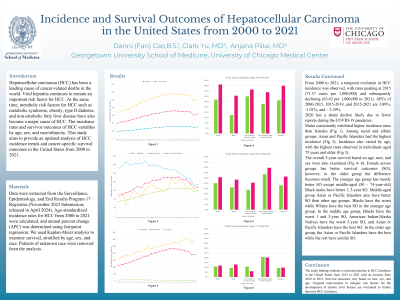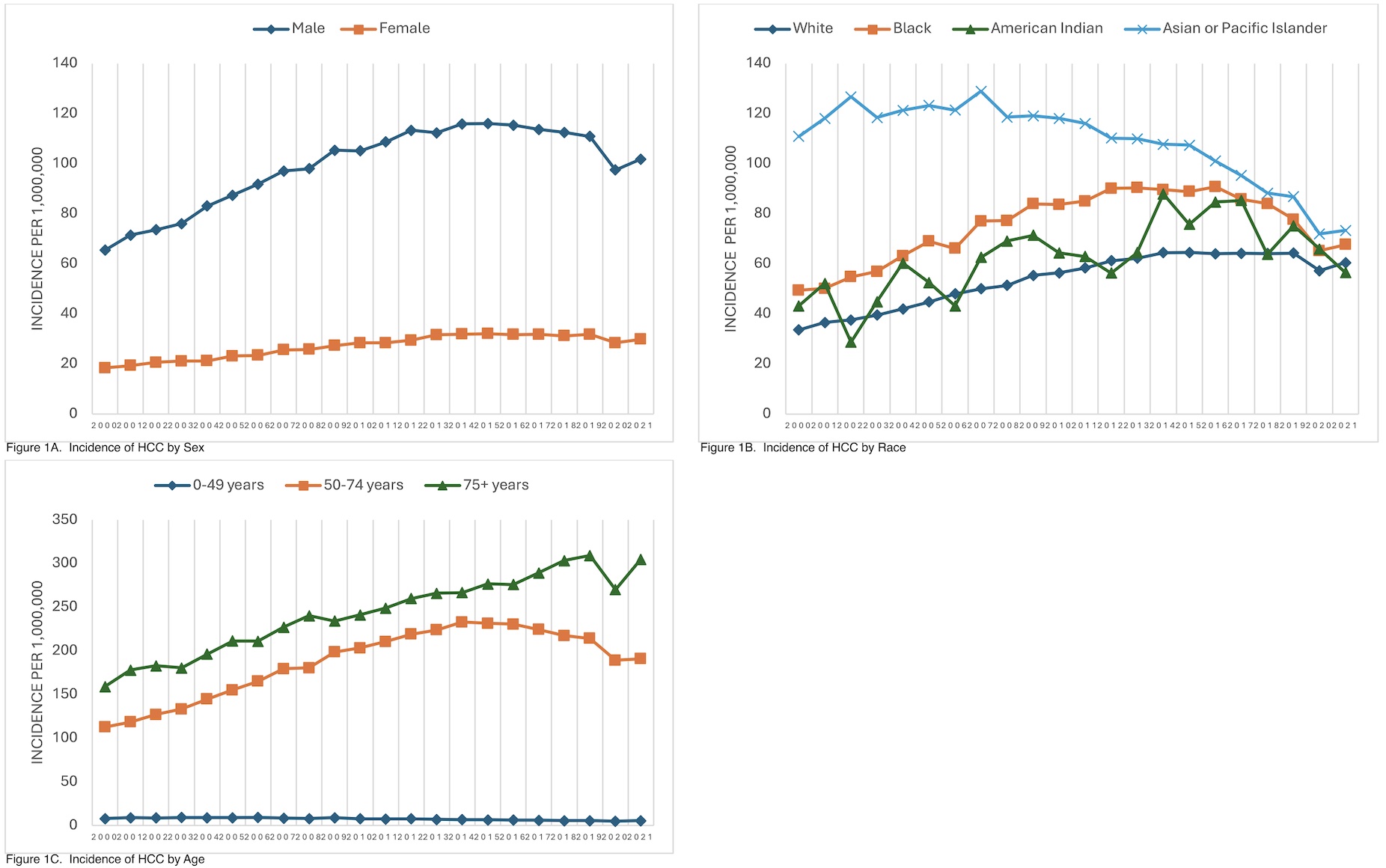Sunday Poster Session
Category: Liver
P1247 - Incidence and Survival Outcomes of Hepatocellular Carcinoma in the United States From 2000 to 2021
Sunday, October 27, 2024
3:30 PM - 7:00 PM ET
Location: Exhibit Hall E

Has Audio
- FC
Fan Cao, BS
Georgetown University School of Medicine
Arlington, VA
Presenting Author(s)
Fan Cao, BS1, Clark Yu, MD2, Anjana Pillai, MD3
1Georgetown University School of Medicine, Washington, DC; 2University of Chicago Pritzker School of Medicine, Chicago, IL; 3University of Chicago Medical Center, Chicago, IL
Introduction:
Hepatocellular carcinoma (HCC) has been a leading cause of cancer-related deaths, particularly among patients with cirrhosis. This study aims to provide an updated analysis of HCC incidence trends and cancer-specific survival outcomes in the United States from 2000 to 2021.
Methods:
Data were extracted from the Surveillance, Epidemiology, and End Results Program 17 Registries (November 2023 Submission). Age-standardized incidence rates for HCC from 2000 to 2021 were calculated, and annual percent change (APC) was determined using Joinpoint regression. We used Kaplan- Meier analysis to examine survival outcomes with 95% confidence interval, stratified by age, sex, and race. Patients of unknown race were removed from the analysis.
Results:
From 2000 to 2021, a temporal evolution in HCC incidence was observed, with rates peaking at 2015 (71.37 cases per million) and subsequently declining (63.43 per million in 2021). APCs of 2000-2015, 2015-2019, and 2015-2021 are 3.89%, -1.01%, and – 2.39%. 2020 has a sharp decline likely due to fewer reports during the COVID-19 pandemic. Males consistently exhibited higher incidence rates than females (Fig 1A). Among racial and ethnic groups, Asian and Pacific Islanders (AAPIs) had the highest incidence (Fig 1B). Incidence also varied by age, with the highest rates observed in individuals aged 75 years and older (Fig 1C). The overall 1-, 3-, and 5-year survival based on age, race, and sex were also examined (Table 1). Female across groups has better survival outcomes (SO), however, in the older group, the difference becomes small. The younger age across race groups has mostly better SO except middle-aged Black males have better 1, 3-year SO than the younger. Blacks have the worst while Whites have the best SO in the younger age group. In the middle age group, Blacks have the worst 1 and 3-year SO, American Indian/Alaska Natives have the worst 5-year SO, and AAPIs have the best SO. In the older age group, AAPIs have the best while the rest have similar SO.
Discussion:
The study findings indicate a consistent decline in HCC incidence in the United States from 2015 to 2021 with an increase from 2020 to 2021. This decline may be attributed to advancements in hepatitis C virus treatments and decreased surveillance during the pandemic. Survival outcomes vary based on race, sex, and age. Targeted interventions to mitigate risk factors for the development of chronic liver disease are warranted to further decrease HCC incidence.

Note: The table for this abstract can be viewed in the ePoster Gallery section of the ACG 2024 ePoster Site or in The American Journal of Gastroenterology's abstract supplement issue, both of which will be available starting October 27, 2024.
Disclosures:
Fan Cao, BS1, Clark Yu, MD2, Anjana Pillai, MD3. P1247 - Incidence and Survival Outcomes of Hepatocellular Carcinoma in the United States From 2000 to 2021, ACG 2024 Annual Scientific Meeting Abstracts. Philadelphia, PA: American College of Gastroenterology.
1Georgetown University School of Medicine, Washington, DC; 2University of Chicago Pritzker School of Medicine, Chicago, IL; 3University of Chicago Medical Center, Chicago, IL
Introduction:
Hepatocellular carcinoma (HCC) has been a leading cause of cancer-related deaths, particularly among patients with cirrhosis. This study aims to provide an updated analysis of HCC incidence trends and cancer-specific survival outcomes in the United States from 2000 to 2021.
Methods:
Data were extracted from the Surveillance, Epidemiology, and End Results Program 17 Registries (November 2023 Submission). Age-standardized incidence rates for HCC from 2000 to 2021 were calculated, and annual percent change (APC) was determined using Joinpoint regression. We used Kaplan- Meier analysis to examine survival outcomes with 95% confidence interval, stratified by age, sex, and race. Patients of unknown race were removed from the analysis.
Results:
From 2000 to 2021, a temporal evolution in HCC incidence was observed, with rates peaking at 2015 (71.37 cases per million) and subsequently declining (63.43 per million in 2021). APCs of 2000-2015, 2015-2019, and 2015-2021 are 3.89%, -1.01%, and – 2.39%. 2020 has a sharp decline likely due to fewer reports during the COVID-19 pandemic. Males consistently exhibited higher incidence rates than females (Fig 1A). Among racial and ethnic groups, Asian and Pacific Islanders (AAPIs) had the highest incidence (Fig 1B). Incidence also varied by age, with the highest rates observed in individuals aged 75 years and older (Fig 1C). The overall 1-, 3-, and 5-year survival based on age, race, and sex were also examined (Table 1). Female across groups has better survival outcomes (SO), however, in the older group, the difference becomes small. The younger age across race groups has mostly better SO except middle-aged Black males have better 1, 3-year SO than the younger. Blacks have the worst while Whites have the best SO in the younger age group. In the middle age group, Blacks have the worst 1 and 3-year SO, American Indian/Alaska Natives have the worst 5-year SO, and AAPIs have the best SO. In the older age group, AAPIs have the best while the rest have similar SO.
Discussion:
The study findings indicate a consistent decline in HCC incidence in the United States from 2015 to 2021 with an increase from 2020 to 2021. This decline may be attributed to advancements in hepatitis C virus treatments and decreased surveillance during the pandemic. Survival outcomes vary based on race, sex, and age. Targeted interventions to mitigate risk factors for the development of chronic liver disease are warranted to further decrease HCC incidence.

Figure: Incidence Trend by Sex, Age and Race
Note: The table for this abstract can be viewed in the ePoster Gallery section of the ACG 2024 ePoster Site or in The American Journal of Gastroenterology's abstract supplement issue, both of which will be available starting October 27, 2024.
Disclosures:
Fan Cao indicated no relevant financial relationships.
Clark Yu indicated no relevant financial relationships.
Anjana Pillai indicated no relevant financial relationships.
Fan Cao, BS1, Clark Yu, MD2, Anjana Pillai, MD3. P1247 - Incidence and Survival Outcomes of Hepatocellular Carcinoma in the United States From 2000 to 2021, ACG 2024 Annual Scientific Meeting Abstracts. Philadelphia, PA: American College of Gastroenterology.
